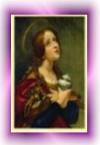St. Rocco dressed in the clothes of a pilgrim and departed for Rome. At that time, Italy was stricken with a rampant disease. St. Rocco cured many with this dreaded disease by praying for them and making the sign of the cross.
During his travels, he too contracted the plague which was evident by an open sore on his leg. St. Rocco was banished from the city and took refuge in a cove. Miraculously, a dog that refused to eat faithfully brought him bread from the table of a neighboring nobleman. The nobleman had pity on St. Rocco and brought him to his castle where St. Rocco was cured.
St. Rocco traveled through northern Italy for two or three more years before returning to his birthplace in France. So weak and sick from suffering, the townspeople did not recognize him and he was thrown into jail as a spy without any proof. But yet, he was kept in prison for five years. On August 16, 1378, a guard entered his cell and found St. Rocco near death. The dungeon was illuminated with a blue light radiating from his body. Upon hearing this, the Governor demanded to know St. Rocco’s identity.
St. Rocco faintly replied, “I am your nephew Rocco.” Only one thing could prove that, so he had him disrobed and the red cross-like mark was visible on the left side of his chest. The Governor and the townspeople present in the cell then believed. A voice from paradise was heard announcing that St. Rocco’s soul had merited immortal glory in Heaven. Even after death, St. Rocco performed many miracles.
St. Rocco is venerated in the Roman Catholic Church as the protector against the plague and all contagious diseases. The statue of St. Rocco is considered unique among theologians because of his pose. It is most unusual because it depicts him with his left hand pointing to an open sore on his left leg. Few images of saints expose any afflictions or handicaps. His body is enclosed in a glass tomb in the church of St. Rocco in Venice, Italy.

